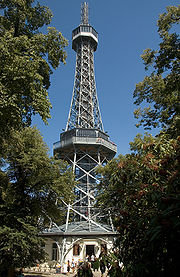
General Land Centennial Exhibition (1891)
Encyclopedia

Prague
Prague is the capital and largest city of the Czech Republic. Situated in the north-west of the country on the Vltava river, the city is home to about 1.3 million people, while its metropolitan area is estimated to have a population of over 2.3 million...
, then in the Austria–Hungarian Empire.
Many buildings were erected for this exposition, including the Průmyslový palace (Industrial Palace).
Summary
Taking place towards the end of the Austria-Hungarian empire this exhibition was a demonstration of what was to soon become CzechoslovakiaCzechoslovakia
Czechoslovakia or Czecho-Slovakia was a sovereign state in Central Europe which existed from October 1918, when it declared its independence from the Austro-Hungarian Empire, until 1992...
's desire for independence. Its date marked 100 years since the first industrial exhibition held in 1791 in Prague's Klementinum when Prague was part of the Habsburg Monarchy
Habsburg Monarchy
The Habsburg Monarchy covered the territories ruled by the junior Austrian branch of the House of Habsburg , and then by the successor House of Habsburg-Lorraine , between 1526 and 1867/1918. The Imperial capital was Vienna, except from 1583 to 1611, when it was moved to Prague...
. The majority German population in Prague attempted to move the 1891 expo to the following year when it could not be used to mark the century. And then when it was held largely boycotted it.
Sometimes known as the Prague Jubilee Exhibition the main site for the fair is now the Prague Exhibition Grounds close to Stromovka Park. The biggest building was the Průmyslový palace designed by Bedřich Münzberger
Opening
The fair was opened on 15 May 1791 by Archduke Karl LudwigArchduke Karl Ludwig of Austria
Archduke Karl Ludwig Joseph Maria of Austria was the younger brother of Franz Joseph I of Austria and the father of Archduke Franz Ferdinand of Austria , whose assassination ignited the start of World War I.-Biography:He was born at Schönbrunn in Vienna, the son of Archduke Franz Karl of Austria ...
and attended by government ministers, the governor Count Franz Thun
Franz, Prince of Thun and Hohenstein
Count Franz Anton von Thun und Hohenstein, was an Austro-Hungarian noble and statesman....
and Prince George Lobkowicz. Josef I
Franz Joseph I of Austria
Franz Joseph I or Francis Joseph I was Emperor of Austria, King of Bohemia, King of Croatia, Apostolic King of Hungary, King of Galicia and Lodomeria and Grand Duke of Cracow from 1848 until his death in 1916.In the December of 1848, Emperor Ferdinand I of Austria abdicated the throne as part of...
did not attend the opening ceremony, but visited the fair later.
The Křižíkova fountain was illuminated.
Legacy
Many buildings from the fair still exist including the Art NouveauArt Nouveau
Art Nouveau is an international philosophy and style of art, architecture and applied art—especially the decorative arts—that were most popular during 1890–1910. The name "Art Nouveau" is French for "new art"...
Hanava Pavilion (close to the huge metronome
Prague Metronome
The Metronome is a giant, functional metronome located overlooking the Vltava River and the city center of Prague. It was erected in 1991, and stands on the plinth left vacant by the destruction of an enormous monument to former Soviet leader Joseph Stalin . The Metronome is now mostly a scenic...
) which is popular for weddings and Petřín Tower a 60 foot copy of the Eiffel Tower. The Křižíkova fountain was reconstructed recently and is still operational.

